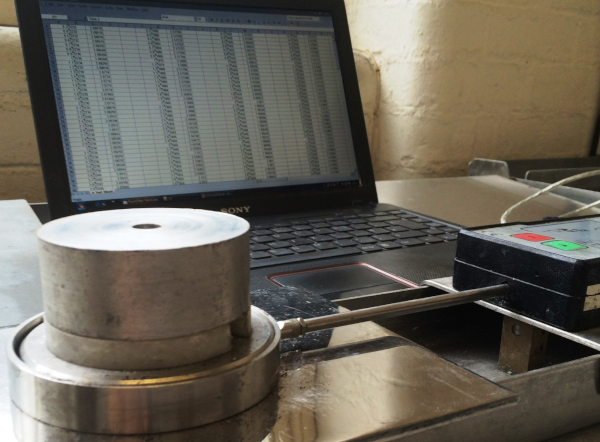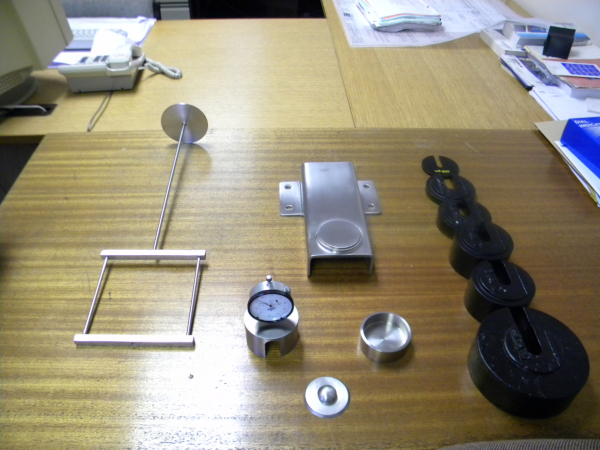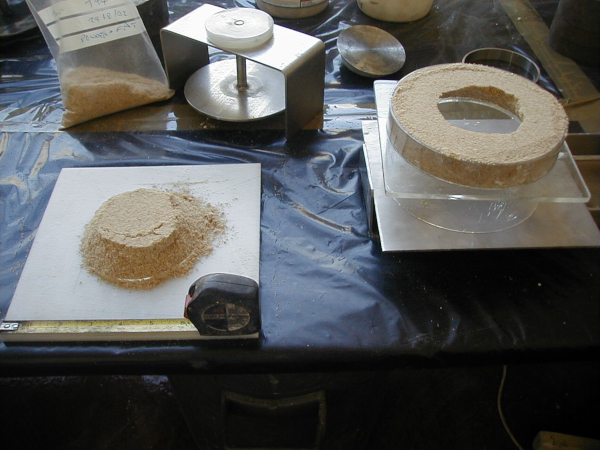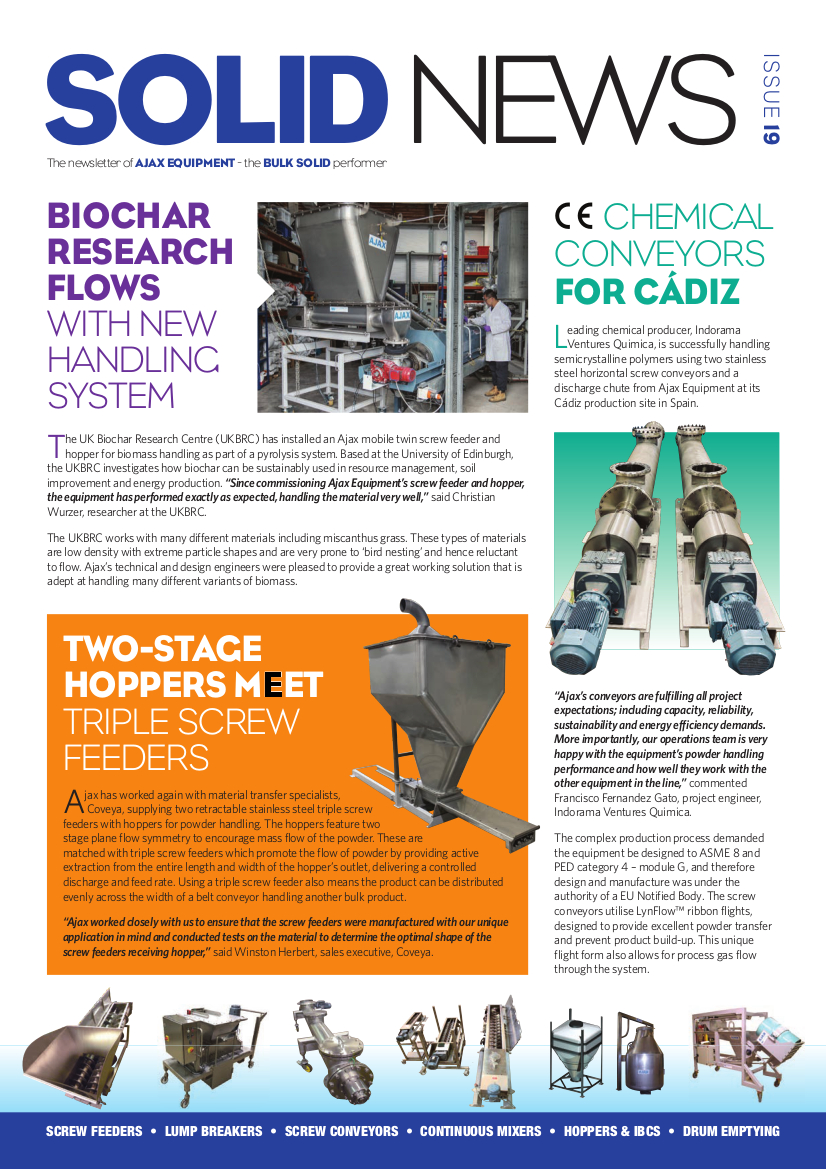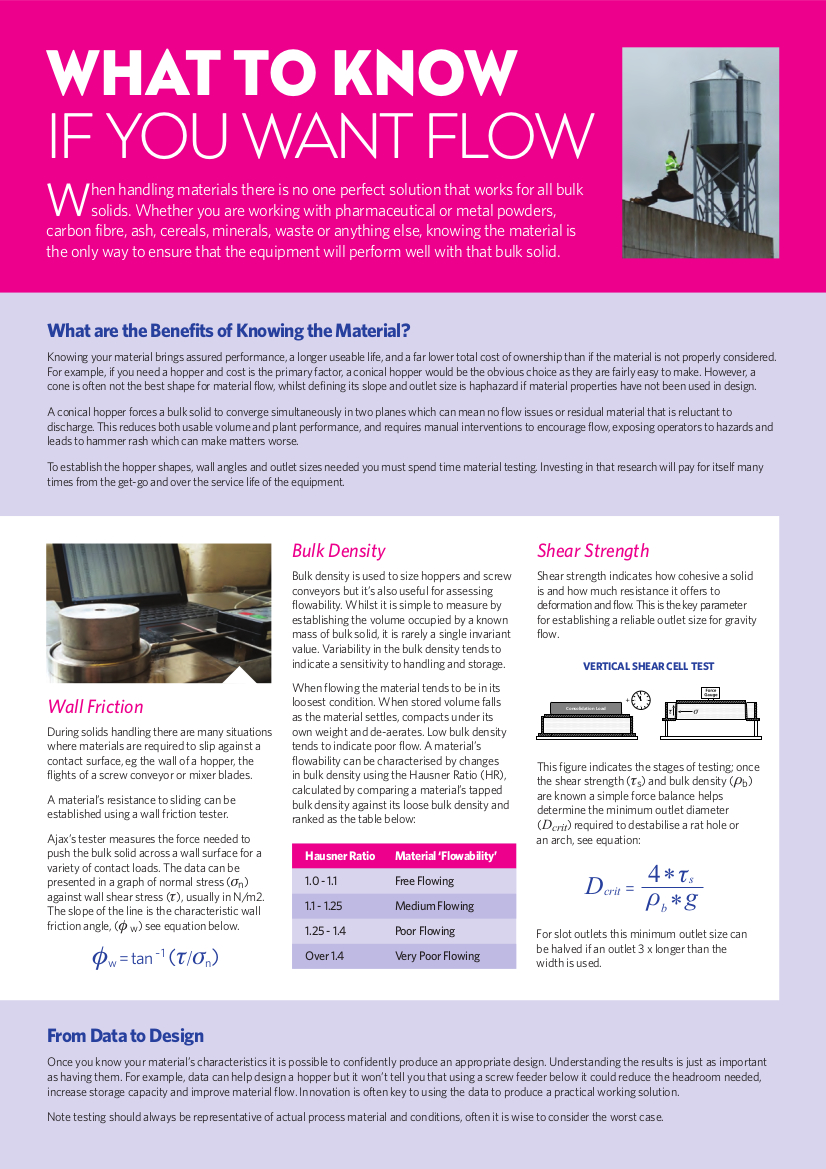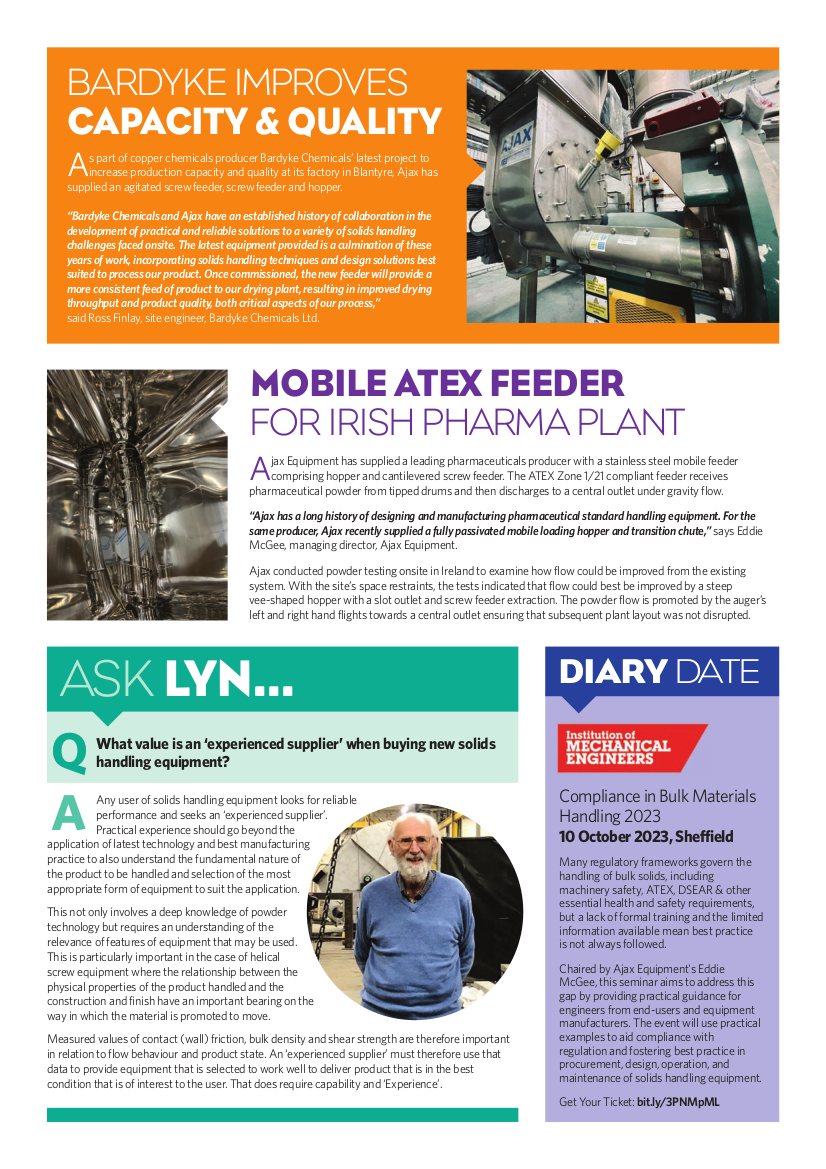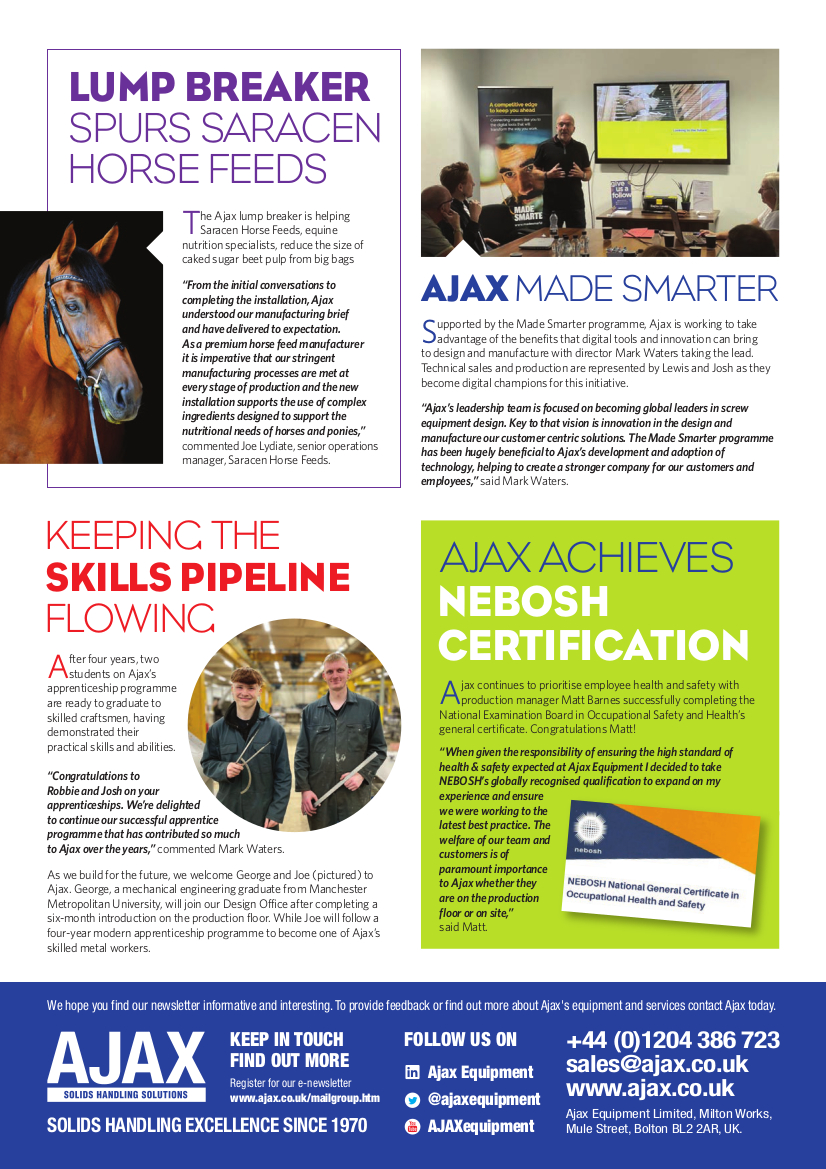AJAX Wall Friction Tester
1. Introduction.
The equipment is designed to directly measure the effects of static and sliding friction between a bulk solid and a contact surface under differing loading conditions. The strength of any surface cohesive or adhesive forces can also be determined under dynamic, static and consolidated conditions.
2. Equipment Description
The equipment, shown in component layout form above (and referred to in Ajax Drawing Number 20539.E) is provided as a rigid stainless steel test bench to which is attached an in-line drive/controller, a traversing platform with force gauge, and the test plate surface.
Drive Unit with Controller
The in-line drive unit comprises a 12-volt DC reversible motor and Control Unit with power supply socket. A transformer is supplied suitable for 240v/1ph/50Hz. as standard. Alternatively, the unit can be adapted for power directly from customer's own supply.
The Drive is coupled to a threaded rod with traversing mounting block to provide forward and reverse movement, at a controlled rate during the test, as well permitting the unit to be stopped as necessary.
Force Gauge Support Platform
The platform travels over a 100 mm distance at a constant 4 mm/min. rate, direction and movement being controlled by the Control Unit as above, with two micro switches confining the limit of travel. The platform supports the Force Gauge and simply lifts off the traversing mounting block on the threaded rod.
Force Gauge Indicator
The Force Gauge Indicator comprises a microprocessor controlled tension/compression unit, 0 to 200N/20Kg/44lb range.
The gauge is supplied in a moulded plastic carry case and comes complete with a mains adapter/charger.
Test Plate Surfaces
Three sample test plates are provided as standard - mild steel, stainless steel (2B finish) and UHMWPE. Alternative test plate surfaces are available on request.
Test Sample Cell
A 95 mm diameter Test Sample Cell holds the sample under test and is complete with a Cell Lid to accommodate the applied weights as well as providing a point of contact for the Force Gauge Spindle. A mould collar, twisting top and wrench are provided for sample preparation.
Weights (Optional) Traceable calibrated weights are offered as an option. The standard set comprising 1 x 5Kg., 2 x 2 Kg., 1 x 1Kg., 1 x 0.5Kg. and 1 x 0.2Kg.
3. Method
A sample of bulk solid is prepared in a circular cell placed upon the test plate. A lid is applied and the force required to promote and sustain slip along the surface is recorded with differing values of supplementary weights added to the cell lid. The resulting data is best plotted to examine for non-linearity and projected conditions for zero applied load to the surface. From this, the characteristic wall friction angle and the surface adhesion/cohesion can be evaluated
4. Uses
Powder slip properties are an important design criteria for both handling and storage of bulk powders and the Ajax Wall Friction Tester incorporates the Jenike method for hopper design which shows that the characteristic wall friction angle is the primary factor for evaluating the wall angle for the required mode of flow.
The prediction of wall loading for both the static and dynamic situations in silos are dependent upon wall friction properties, as are the velocity patterns and their consequences to wear and attrition.
Mechanical handling mechanisms such as chutes and screw conveyors also depend upon the powders slip behaviour in ensuring that effective transfer is obtained, as are self clearing and residue conditions.
Material specifications for quantifying both powder and test surface condition on a performance-related basis.
Categorisation of materials and assisting in information gathering about variations or similarities with dissimilar materials or reference standards.
A principle use of the Tester is for comparison of differing contact surfaces so that the material of equipment construction can be optimised for frictional conditions.
2. Equipment Description
The equipment is provided as a rigid stainless steel test bench to which is attached an in-line drive/controller, a traversing platform with force gauge, and the test plate surface.
Drive Unit with Controller
The in-line drive unit comprises a 12-volt DC reversible motor and Control Unit with power supply socket. A transformer is supplied suitable for 240v/1ph/50Hz. as standard. Alternatively, the unit can be adapted for power directly from customer's own supply.
The Drive is coupled to a threaded rod with traversing mounting block to provide forward and reverse movement, at a controlled rate during the test, as well permitting the unit to be stopped as necessary.
Force Gauge Support Platform
The platform travels over a 100 mm distance at a constant 4 mm/min. rate, direction and movement being controlled by the Control Unit as above, with two micro switches confining the limit of travel. The platform supports the Force Gauge and simply lifts off the traversing mounting block on the threaded rod.
Force Gauge Indicator
The Force Gauge Indicator comprises a microprocessor controlled tension/compression unit, 0 to 200N/20Kg/44lb range.
The gauge is supplied in a moulded plastic carry case and comes complete with a mains adapter/charger.
Test Plate Surfaces
Three sample test plates are provided as standard - mild steel, stainless steel (2B finish) and UHMWPE. Alternative test plate surfaces are available on request.
Test Sample Cell
A 95 mm diameter Test Sample Cell holds the sample under test and is complete with a Cell Lid to accommodate the applied weights as well as providing a point of contact for the Force Gauge Spindle. A mould collar, twisting top and wrench are provided for sample preparation.
Weights (Optional) Traceable calibrated weights are offered as an option. The standard set comprising 1 x 5Kg., 2 x 2 Kg., 1 x 1Kg., 1 x 0.5Kg. and 1 x 0.2Kg.
3. Method
A sample of bulk solid is prepared in a circular cell placed upon the test plate. A lid is applied and the force required to promote and sustain slip along the surface is recorded with differing values of supplementary weights added to the cell lid. The resulting data is best plotted to examine for non-linearity and projected conditions for zero applied load to the surface. From this, the characteristic wall friction angle and the surface adhesion/cohesion can be evaluated.
4. Uses
Powder slip properties are an important design criteria for both handling and storage of bulk powders and the Ajax Wall Friction Tester incorporates the Jenike method for hopper design which shows that the characteristic wall friction angle is the primary factor for evaluating the wall angle for the required mode of flow.
The prediction of wall loading for both the static and dynamic situations in silos are dependent upon wall friction properties, as are the velocity patterns and their consequences to wear and attrition.
Mechanical handling mechanisms such as chutes and screw conveyors also depend upon the powders slip behavior in ensuring that effective transfer is obtained, as are self clearing and residue conditions.
Material specifications for quantifying both powder and test surface condition on a performance-related basis.
Categorisation of materials and assisting in information gathering about variations or similarities with dissimilar materials or reference standards.
A principle use of the Tester is for comparison of differing contact surfaces so that the material of equipment construction can be optimised for frictional conditions.
